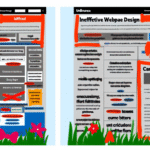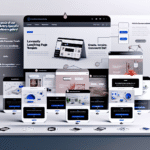Crafting a visually compelling, high-converting landing page is more important than ever in today’s crowded digital landscape. Whether you’re a startup looking to increase sign-ups or an established brand aiming to drive more product sales, the landing page experience can make or break your success. Two popular platforms that are focused on creating design-driven landing pages stand out for marketers and designers: Unbounce and Framer.
While both tools let you build eye-catching and effective pages, they cater to slightly different needs and skill sets. In this post, we’ll explore the key features, advantages, and potential drawbacks of Unbounce and Framer so you can decide which platform best suits your landing page goals.
1. Overview: Unbounce vs. Framer
Unbounce
Unbounce is a dedicated landing page and conversion optimization platform. Created to help marketers and business owners easily build, test, and optimize landing pages—without relying heavily on developers—Unbounce has a robust set of features for A/B testing, dynamic text replacement, and customizable templates. Its user-friendly interface makes it a go-to choice for marketing teams and small businesses prioritizing quick deployment and data-driven optimization.
Key Strengths
- User-Friendly Interface: Drag-and-drop builder suitable for non-technical users.
- Conversion-Focused: Built-in tools for A/B testing, lead gen forms, and analytics.
- Extensive Template Library: Ready-made, mobile-responsive templates designed for high conversion rates.
- Marketing Integrations: Seamless connectivity with popular tools such as HubSpot, Mailchimp, and Salesforce.
Framer
Framer began as a powerful prototyping tool for designers and has evolved into a robust platform for building visually striking websites and landing pages. It’s built with a design-first approach and provides real-time collaboration features that teams love. Framer is particularly appealing to creative professionals who want fine-grained control over every design element—and who may be comfortable with some light coding or advanced design concepts.
Key Strengths
- Design Flexibility: A platform built for designers, offering pixel-perfect control over layouts and elements.
- Real-Time Collaboration: Enables teams to work simultaneously on designs, speeding up the revision process.
- Smooth Animations & Interactions: Great for more advanced micro-interactions and on-page animations.
- Prototyping & Website Building in One: Ideal for designers who want to move from concept to launch without switching tools.
2. Ease of Use
Unbounce
Unbounce’s drag-and-drop editor is intuitive—perfect for marketers or entrepreneurs without extensive design backgrounds. You can customize pre-built templates or start from scratch, but the platform shines in its ability to quickly launch a landing page and start collecting leads. Moreover, its well-documented guides, tutorials, and responsive support make it relatively easy to learn.
Framer
Framer offers a more designer-centric interface that may involve a learning curve if you’re not used to designing or prototyping software. Though the platform has added many features to make it easier for non-designers (like pre-designed components), the interface remains more advanced compared to simpler page builders. However, for teams and businesses that value complete control and stunning design, Framer’s workflow can be deeply rewarding once you’re accustomed to it.
Winner for Ease of Use: Unbounce (for most marketing-focused teams). Framer (for design-savvy professionals).
3. Design Capabilities
Unbounce
While Unbounce provides a variety of templates and design customization options, it primarily aims to optimize user flows and conversion. You can certainly create polished pages that look professional, but complex layouts, custom animations, and intricate design features might be somewhat limited compared to Framer.
Framer
Framer is built with a design-first mindset. You have near-limitless freedom to create pixel-perfect layouts, animations, and interactions. It’s easier to implement design flourishes that help you stand out from cookie-cutter templates. If high-end design, rapid prototyping, and unique user experiences are top priorities, Framer has a clear edge.
Winner for Design: Framer.
4. Conversion Optimization Features
Unbounce
Unbounce excels at conversion optimization—arguably its biggest selling point. The platform offers built-in A/B testing, dynamic text replacement (especially helpful for tailoring messaging to different audience segments), and various widgets for pop-ups and sticky bars. Plus, Unbounce’s analytics and insights are tailor-made for marketers looking to refine their funnel for the best ROI.
Framer
Framer, while visually innovative, may require additional third-party integrations or custom code snippets for robust A/B testing, advanced analytics, and other conversion-oriented needs. While it does have integrations with marketing tools, it’s not primarily designed as a conversion optimization platform, so you might have to set up your own Google Analytics or other event-tracking processes.
Winner for Conversion Optimization: Unbounce.
5. Integrations & Ecosystem
Unbounce
Unbounce plays nicely with a wide range of marketing and CRM tools. It integrates directly with platforms such as:
- HubSpot
- Marketo
- Mailchimp
- Salesforce
- Zapier (for hundreds of additional integrations)
This makes it an ideal solution for marketers who need immediate lead capture and CRM synchronization without heavy development.
Framer
Framer also supports integrations, though the list may not be as robust out-of-the-box as what you’ll find in Unbounce. Most critical integrations (like analytics, CMS systems, and marketing automation platforms) are possible, but you may need to rely on more manual or custom setups via webhooks, APIs, or Zapier-like tools. If you’re comfortable doing a bit of legwork, Framer can fit into broader marketing stacks, but it’s not as plug-and-play as Unbounce.
Winner for Integrations: Unbounce (especially for marketing automation and CRM).
6. Pricing
Unbounce
Unbounce offers several pricing tiers starting at around $99 per month for its Launch plan, aimed at small businesses or those just starting out. As you scale up, expect higher monthly fees but also additional features and higher visitor allowances. If your goal is straightforward—building multiple landing pages, capturing leads, and running tests—Unbounce’s pricing can be seen as an investment in boosting conversions.
Framer
Framer’s pricing starts with a free plan for personal use, then moves to Pro and Enterprise tiers with advanced collaboration and publishing features. The paid plans tend to focus on enabling more team members, unlocking premium design features, and removing Framer branding. While more affordable at the entry-level, you need to consider potential additional costs for third-party integrations if you need advanced marketing functionality.
Verdict on Pricing: Unbounce is more expensive but is an all-in-one solution for landing pages and conversions. Framer can be more cost-effective for individuals or smaller teams but may require extra spending on external services for full marketing capabilities.
7. Use Cases & Ideal Users
When Unbounce is Best
- Marketers who need quick, reliable landing pages without heavy designer or developer overhead.
- A/B testing enthusiasts who want to get the most out of every campaign.
- Teams with minimal coding skills looking for easy-to-use templates and a simple drag-and-drop experience.
When Framer is Best
- Design-driven brands that emphasize unique, memorable aesthetics and user experiences.
- Agencies or larger teams with in-house design talent can leverage Framer’s advanced prototyping and collaboration features.
- Businesses want intricate interactions and custom animations to make their landing pages stand out.
8. Final Thoughts
Choosing between Unbounce and Framer largely depends on your team’s skills and your project’s priorities. If your focus is on quick deployment, robust A/B testing, and seamless integrations with your marketing stack, Unbounce is an outstanding option. However, if you seek pixel-perfect designs, high-fidelity prototypes, and advanced interactive capabilities, Framer will give your team the design freedom they need.
No matter which platform you choose, remember that landing page success ultimately hinges on a balance of design, messaging, and data-driven optimization. Whichever tool you opt for, invest time in refining your copy, visuals, and user experience. Then, test and iterate. Even the most beautiful page needs ongoing optimization to consistently deliver high conversion rates.
Ready to Launch Your Next Design-Driven Landing Page?
- Try Unbounce if you want a quick start with conversion-focused features and an extensive suite of integrations.
- Explore Framer if design flexibility and high-end interactions are top priorities for your brand.
Both platforms have free trials or freemium tiers, so consider experimenting with each to see which one best aligns with your team’s workflow and objectives. With the right blend of creativity and strategy, you’ll soon have landing pages that both impress and convert.
For more information about our work, please refer to this page.





